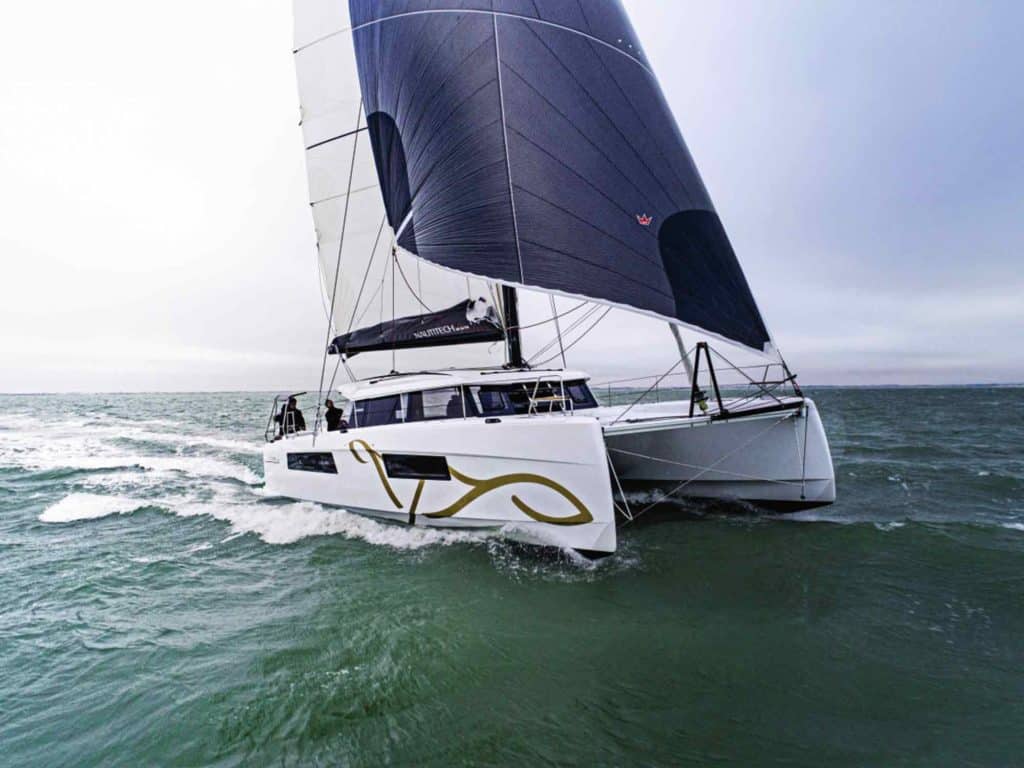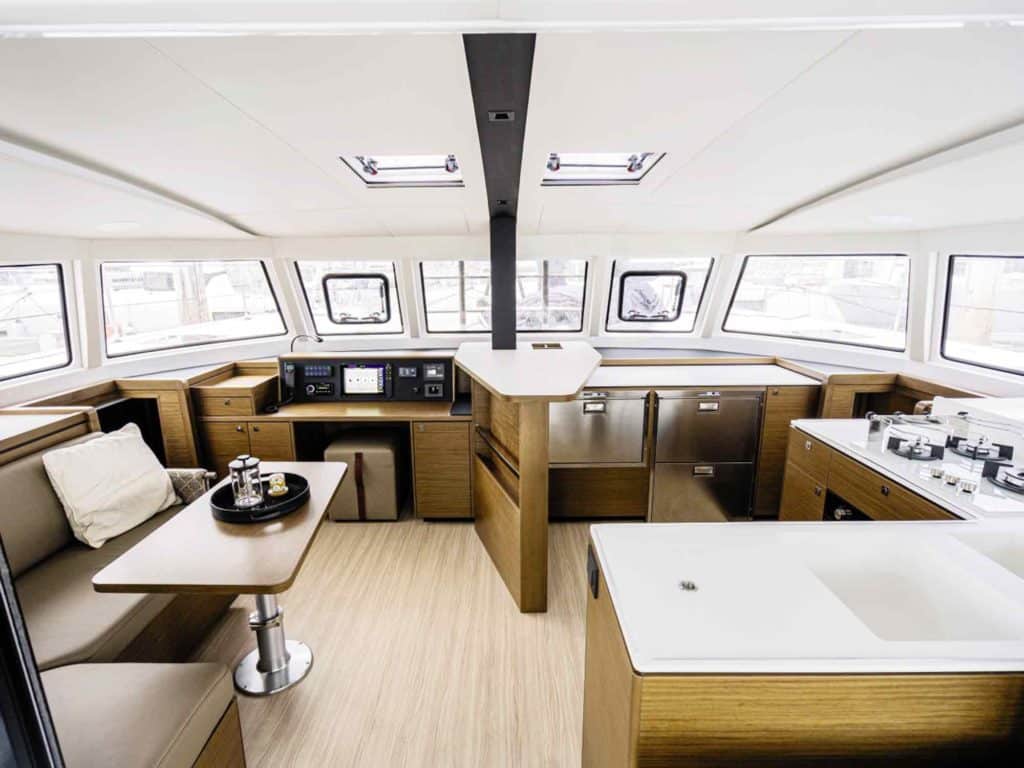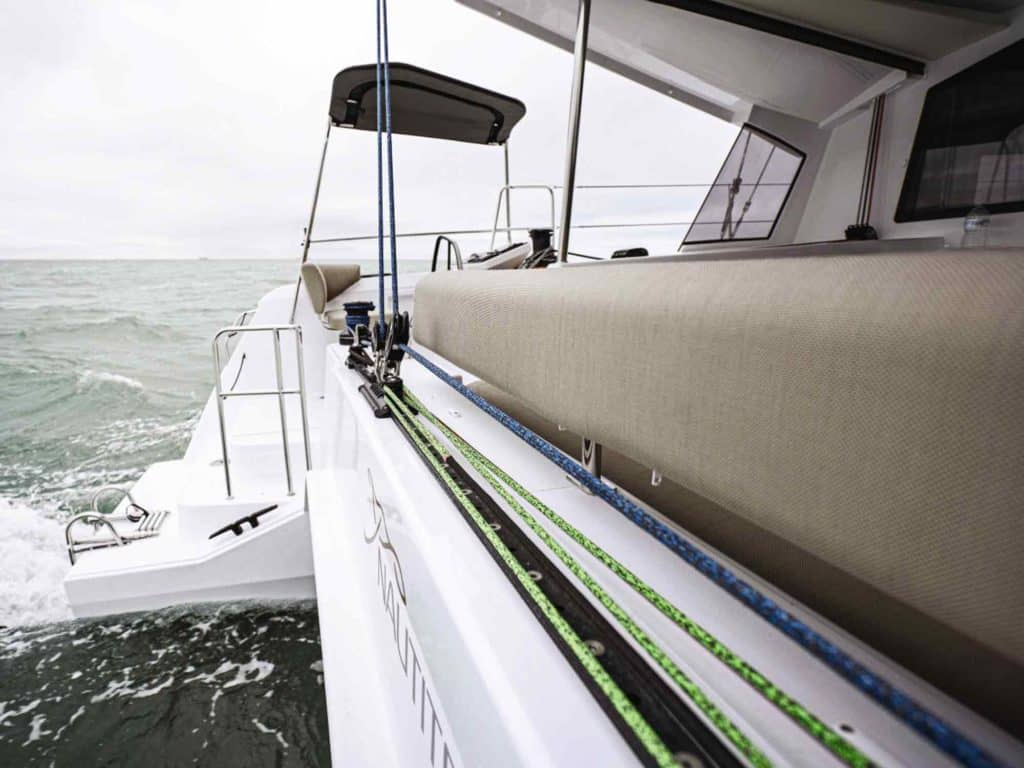
There’s more than one way to design a cat, so the team at Nautitech asked owners and dealers what they would like to see in a midsize cruising multihull from the yard in Rochefort, France. The result is the 44 Open, a fine sailing catamaran that’s fit out for owners on the go.
“It’s a catamaran designed by sailors for sailors,” Nautitech general manager Gildas Le Masson said during the boat’s introduction at the Miami International Boat Show in February.
This is the first new Nautitech model since the company reintroduced the brand three years ago, and it reflects a decision to focus on the needs of private owners—often couples, families or other shorthanded crews. Previously, perhaps 60 percent of Nautitechs ended up in charter; going forward, a company representative estimates, those numbers could shrink to just 10 percent of annual sales.
The 44 Open joins a four-model range that includes the 40 Open, 46 Open and 46 Fly. Nautitech also builds a 47-foot power cat. Open refers to the feeling of being in the outdoors: Cockpits have generously sized dining tables; large windows encircle the saloon; and steering is done from helms outboard and aft on the transoms. The 46 Fly, by comparison, is more similar to production cats that populate charter fleets, with a helm station and entertainment area atop the Bimini. Le Masson said that there is not a plan to offer a flybridge option for the 44 Open.
The location of the helms is one feature I really like. At either wheel, you get a clear view of the sails, and by moving around a bit, you get good all-round visibility underway. What’s more, you get the sense of sailing that sometimes goes missing on production cats: the wind in your face and the sound of the water as the boat slices through it.
We got a good dose of both on an afternoon test sail. Motoring out of Miami’s Government Cut, the twin 50 hp Volvo Penta diesel engines and saildrives (30 hp Volvo Pentas are standard) pushed us along at 7.6 knots at cruising speed (2,100 rpm). The speedo jumped past 9 in get-home-quick mode (2,700 rpm).
The real fun came, though, when we raised the square-top main, rolled out the furled, self-tending jib, and turned off the noise. In 12 knots of breeze, the Nautitech tacked back and forth hard on the wind, making 6.5 knots according to the GPS. Cracked off to a beam reach (a point of sail that’s much more favorable to a catamaran), we saw the speed jump to the high-7- to low-8-knot range, and then into the high 8s when we deployed the code zero that’s flown on an aluminum bowsprit.

During my trick at the wheel, I even saw a couple of 10-plus-knot readings when the boat took off on a puff and caught a wave just right. Naval architect Marc Lombard designed the 44 Open, and he demonstrated once again that he knows how to draw slippery hulls.
Color-coded traveler lines—red for port, green for starboard—took the guesswork out of adjusting the main, and electric winches made trimming the headsails nearly effortless. There was a small crowd of us aboard for the sea trial, and I thought that the layout topsides worked well. Having the wheels to either side of the cockpit let the skipper socialize without others encroaching on the area that’s actually needed to sail the boat.
The cockpit itself had long seats to either side, shaded by the Bimini. Two tables were to starboard, and their tops could unfold to create one dining table that ran the length of the seat. Forward of them, with the large sliding door open, it was hard to tell the dividing line between the saloon and outside. Inside, an L-shaped galley was to starboard, with a stove and cooktop outboard, and two large sinks facing aft so that dishes could be passed forward and go right into them. There was loads of counter space for preparing meals, and fiddles were there to keep things from sliding off in a seaway.

Forward in the saloon, three fridge/freezer drawers were in the starboard corner; to port was a forward-facing nav desk that would be perfect for standing a protected watch on a dark, squally night. Between the fridge and desk, builder and designer Christophe Chedal Anglay added a stand-up bar that wrapped around the mast’s compression post and extend aft into the saloon. Dockside, I wasn’t quite sure what to make of it, but out sailing, standing with my arm on it, the bar began to grow on me. I could see it being a natural gathering place when friends came to visit, sort of like the island is in a kitchen back home.
Hull, deck, cabin top and Bimini are all vacuum-infused, using Divinycell for coring. Furniture and bulkheads are also cored to cut down on weight. As with most cats, there are options when it comes to living accommodations. This boat had the owners’ stateroom to port with a queen berth aft, a head compartment amidships and a shower area forward. To port were two guest staterooms with a shared head and shower between them. A four-cabin, two-head layout is another option, and Nautitech offers a “smart room” that transforms one of the forward cabins into a utility-type space. It definitely would be something I’d consider if I were an owner with extended-cruising plans.
Overall, I liked the looks of the Nautitech—its reversed bow, the boom mounted low above the coachroof, and the sweeping curve of the deck line were all eye-catching. But to be honest, it was the location of the helms that got me first and foremost. “Let’s go sailing,” they said.
Mark Pillsbury is a CW editor-at-large








